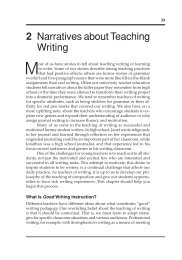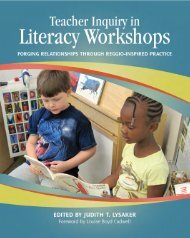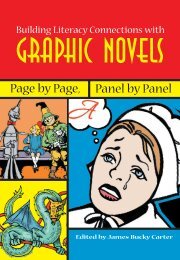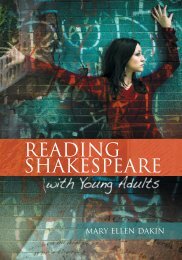Wood_cover.qxd (Page 1) - National Council of Teachers of English
Wood_cover.qxd (Page 1) - National Council of Teachers of English
Wood_cover.qxd (Page 1) - National Council of Teachers of English
- No tags were found...
You also want an ePaper? Increase the reach of your titles
YUMPU automatically turns print PDFs into web optimized ePapers that Google loves.
Interdisciplinary Connections 81discuss the poem together to help students dis<strong>cover</strong> how this poemmight be a mnemonic device in itself. How might the speaker or Lee beusing this poem to remember his father? Does it work? Why or why not?Classroom Snapshot: I used this discussion time with my class to relatethe poem “Mnemonic” to the memory pieces my students wroteat the beginning <strong>of</strong> this lesson. I passed students’ writing out to themand asked them to compare their memories to those that Lee wroteabout in his poem. Most students realized that if they wrote aboutevents that happened a long time ago they were less likely to rememberdetails, while those students who wrote about a pet that they stillowned or a place they had just visited were able to describe it muchmore accurately. From this, students were able to conclude that thespeaker in “Mnemonic” still had the sweater that his father gave himbecause he described it in great detail, but they thought the fatherprobably died a long time ago since the speaker could not rememberas much about him as he could about the sweater.Activity: Representing Memory in the BrainNow that students have learned some basic information about howmemory works in the brain and have related that information to Lee’spoem, it’s time for them to use what they know about memory to createsomething new. Put students into groups <strong>of</strong> three or four and askeach group to choose a product from the lists below. Groups should signup for one <strong>of</strong> the categories to make sure everyone is not making similarthings. Ultimately, it works best to see two or three products fromeach category in the classroom at the end <strong>of</strong> the project.Informational: brochure, PowerPoint, poster, research paper,pamphlet, public service announcement . . .Creative: sculpture, drawing, painting, game, diagram . . .Personal: poem, story, letter, photography with captions . . .The goal <strong>of</strong> this activity is for students to create something that showswhat they have learned about memory and the brain. Students shoulduse the brain questions that they answered earlier as a guide whileworking on their products. For example, students might make a brochureinforming people about the causes <strong>of</strong> memory loss. They mightalso create a diagram or a clay model to show the different parts <strong>of</strong> thebrain that are responsible for memory, or they could write a poem describinga mnemonic device that works for them.
















